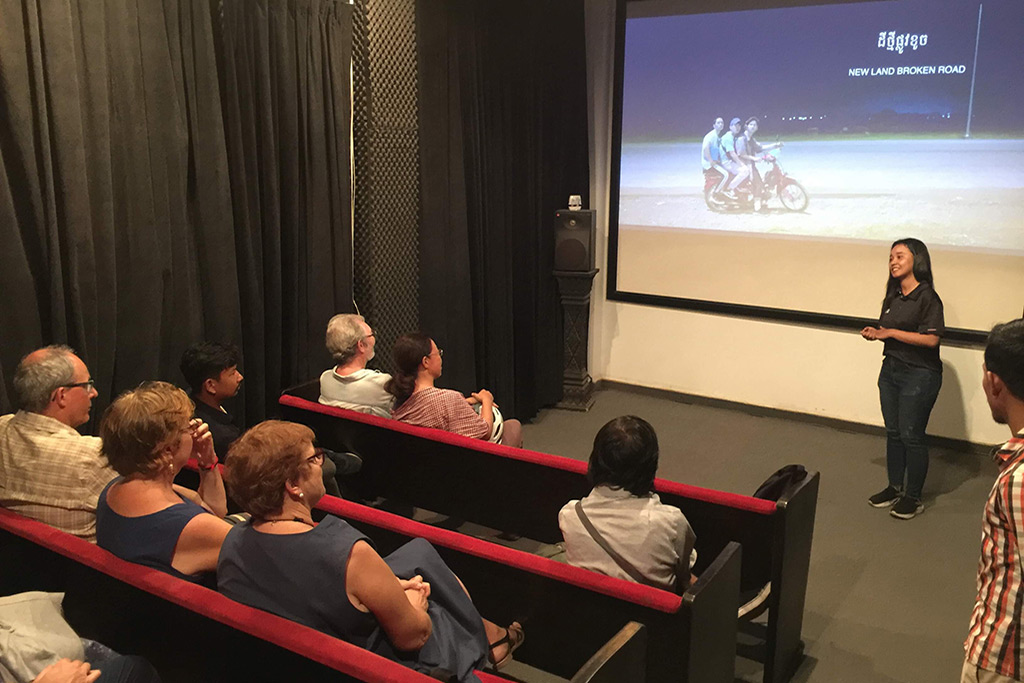
As part of the SEAM Space Phnom Penh public programme, two special film screenings on the topic of “Modernism in Cambodia” took place at the Bophana Audiovisual Resource Center on 19 and 28 October.
Bophana, founded by Cambodian film director Rithy Panh in 2006, “acquires film, television, photography and sound archives on Cambodia from all around the world and gives free public access to this precious heritage”. In addition to providing an “exceptional documentary film database”, Bophana supports artistic creation in all its forms and has become a discussion forum for artists as well as a place of learning for young Cambodians who are being trained here for a career in film, broadcasting and new media.
In conjunction with the exhibition, the curators of Folding Concrete organized special screenings of La Joie de Vivre, New Land Broken Road, and The Burnt Theater.
“La Joie de Vivre” (Norodom Sihanouk, 1968, 65 Min.)
The film portrays modern life of elite society in Cambodia after independence. Police captain Siporak and inspector Sam Baun raid the gambling place at Kirirom owned by Prince Chantavong. This gambling place is disguised as an orchid flower shop. As soon as Prince Chantavong is detained in jail, his wife, princess Sulpra spends her time having fun with her husband’s nephew, and later with a wealthy hotelier. Prince Chantavong discovers everything after he is released from jail. But he still forgives his wife and starts a new life.
“The Burnt Theater” (Rithy Panh, 2005, 83 Min.)
While much of Cambodia’s cultural heritage was eradicated through the deaths of many artists during the Khmer Rouge era, the Preah Suramarit National Theatre remained standing throughout the Cambodian Civil War. Ironically, it was while the theatre was undergoing repairs in 1994 that it caught fire, was heavily damaged and has never been restored. The story centers on lives of some artists living and working at the deteriorated theater, a symbol of decline of modernity produced during the independence era.
“New Land Broken Road” (Neang Kavich, 2018, 15 Min.)
Phnom Penh at night. Three young hip-hop dancers drive a single motorbike and stop on a muddy deserted road. Nick leaves the others to look for an iPhone he heard was lost in the area. Piseth and Thy discuss their hopes and doubts, and Piseth shows his best Michael Jackson moves. They meet Leakhena, a young female street vendor whose cart is full of colors. Dream and reality collide within the backdrop of newly developed urban landscape.
The three films were carefully chosen because of their respective narratives of Cambodian modernity across time through fashion, dance, music and more importantly architecture and urbanism. While the “La Joie de Vivre” paints a picture of luxurious, modern living in an architecturally renewed city of Phnom Penh during the 1960s, “The Burnt Theater” highlights a sad reality of the 1960s urban legacy being left to decay and demolition. “New Land Broken Road,” on the other hand, provides an ambiguous future of Phnom Penh amidst rampant development of new residential complexes through hopes and dreams of young people.
The film screenings at Bophana attracted interested visitors from different disciplines, furthering the discourse on the interwoven narratives of Modernism in Cambodia across time from post-independence era to the current regime. Some audience mentioned the disappointment of the architectural and urban legacy from the 1960s and questioned the practice of urban development now. Some of them came to learn about Folding Concrete exhibition through the screenings and subsequently went to visit the show.

